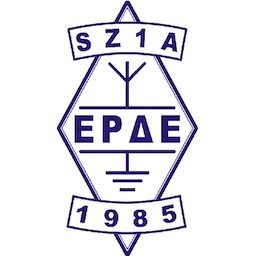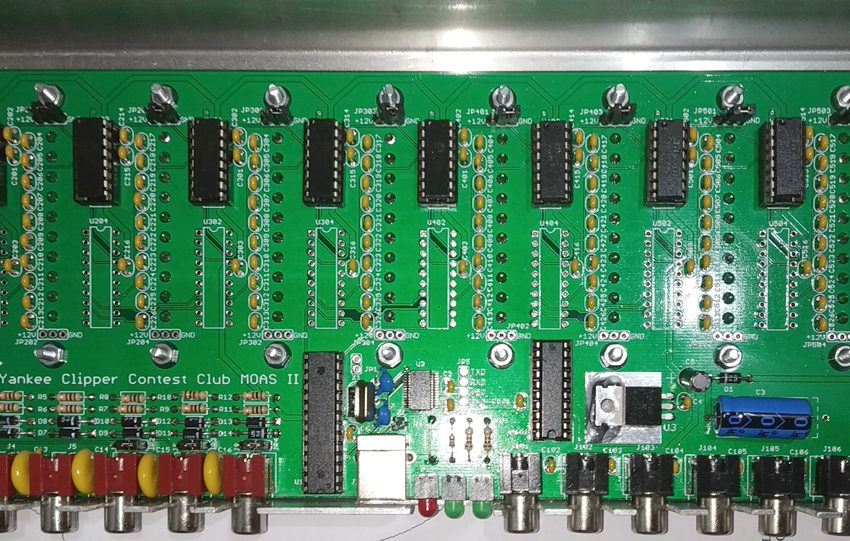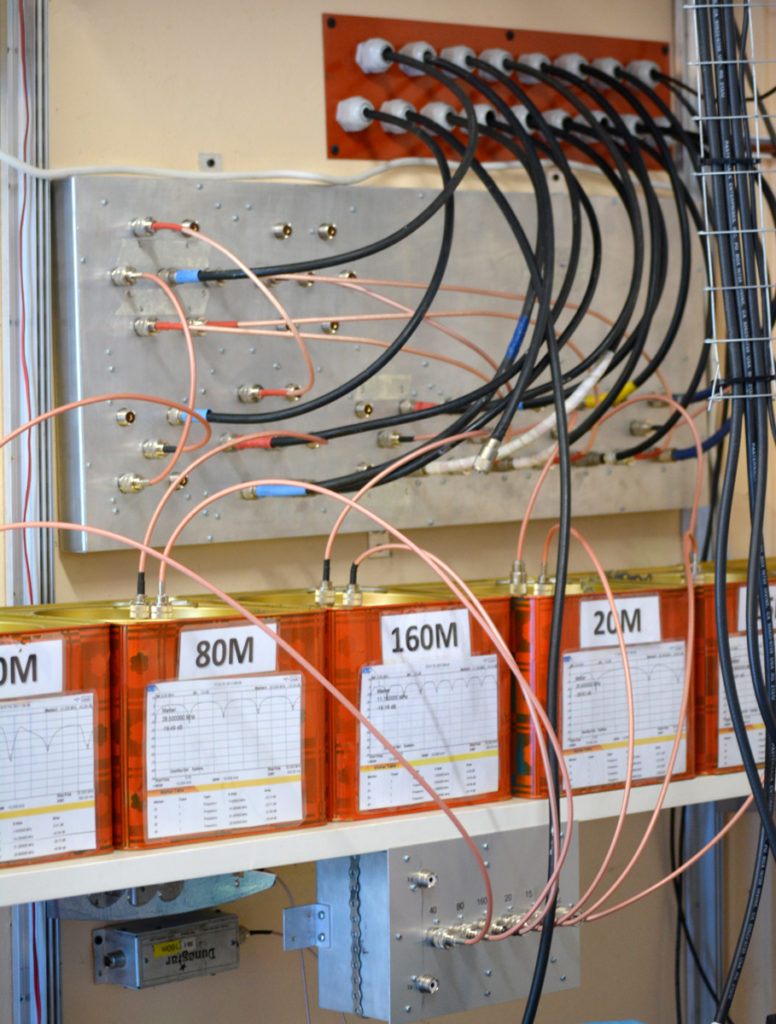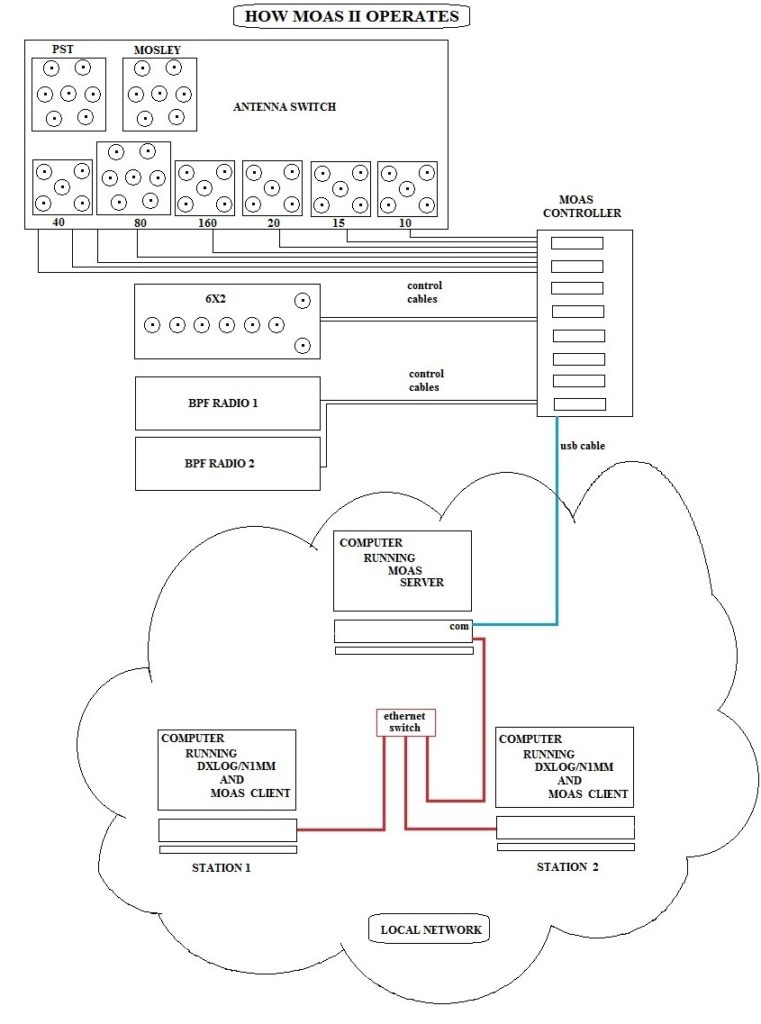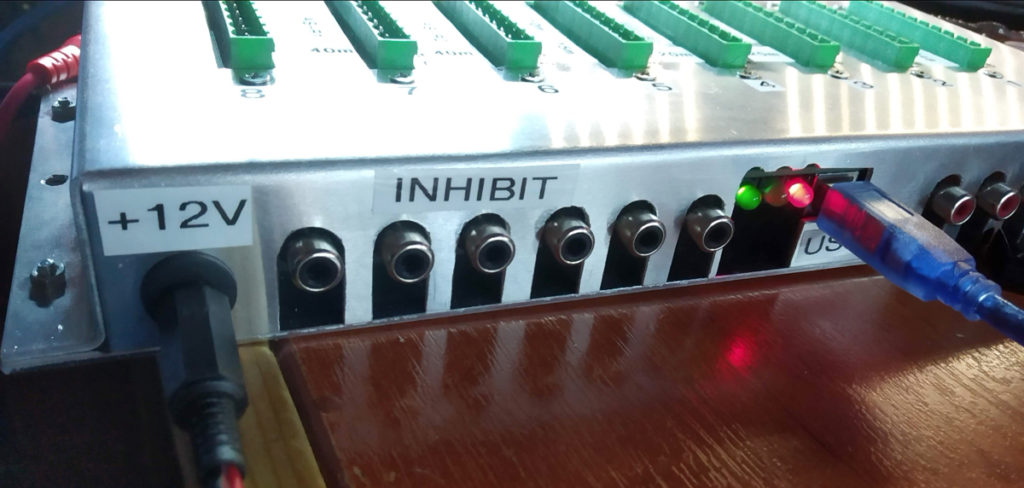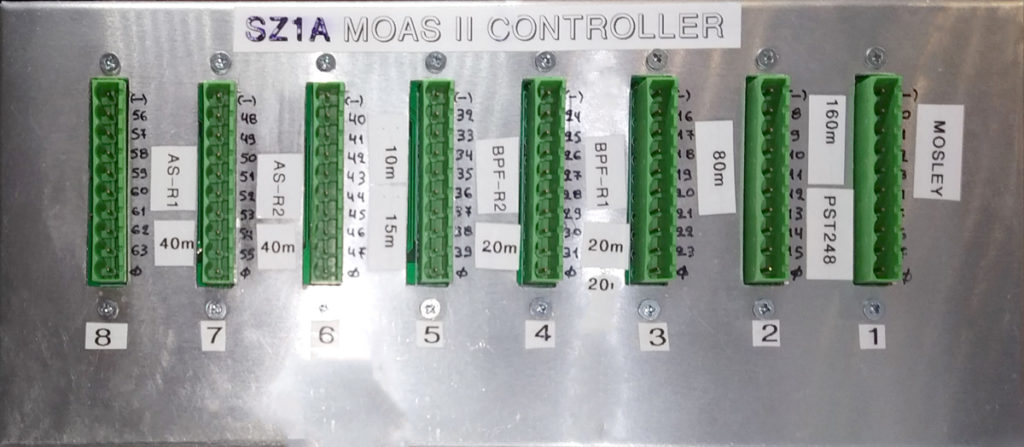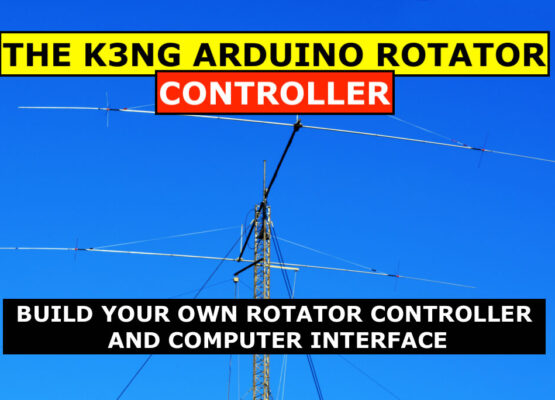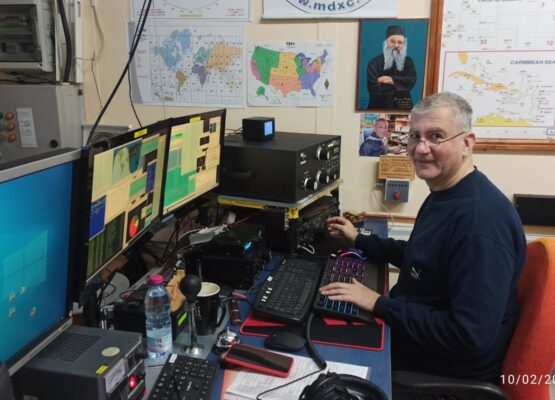Background…
First of all… some history. Paul K1XM made a controller for the Yankee Clipper Contest Club, which he named “Mother of all Switches” (ie. MOAS). The aim was to automate and therefore make it easier to control an amateur radio station.
The problem…
Today, most respectable shacks have relays or switches that do various jobs. For example, when selecting a bandpass filter, or when selecting another antenna, etc. This is usually done manually in most shacks, especially in the beginning. For example, by manually connecting the correct antenna to the corresponding component. Later on, a rotary switch will do this job, which one might use to change the band on the filter: 10, 15, 20, etc. There might be another one that changes antennas. So to change the band, the operator is required to perform an entire workflow of actions: “press ESC, then turn the red switch, then the green, .etc ….”
For there to be automation, there first must be organization.
But when a second radio comes into play, things get very complicated, to the point that error is very likely. Especially when the operators are not operating from their home base-station shack, but are guests at, for example, a club station, and, they have to learn the entire process and understand it in a few minutes. When more than one antenna is inserted for each band, it becomes a nightmare…
The solution…
Paul K1XΜ trying to solve this problem invented the MOAS and then the MOAS II. So what was Paul’s concept? I’ll make a device, the MOAS Controller, and connect it via USB to the computer. At the same time, I’ll run an application on this computer, the MOAS Server, that “talks” to this device. In the application, I’ll upload a file that defines and describes how my station is made (Station Architecture & Topology). In essence, I’ll say that I have “these 10 antennas”, “these two bandpass filters”, etc and at the same time I’ll tell it, that for “that” antenna and “that” BPF for “that” radio, the following relays must be activated. To select another antenna, another BPF and another radio, some other relays need to be activated, etc. Simple, right?
Not so simple after all…
First of all, one has to design their shack in such a way that all this can be done. That is for there to be automation, there first must be organization. In other words, we must organize the selection of antennas in such a way that by activating corresponding relays they can be selected. Beyond that, instead of manually activating the right relay combination, MOAS can take over the job. For example, see in the diagram below the architecture design, and how many switches were needed to implement this project at SZ1A for Multi-Single or SO2R topology configuration (for M2 configuration which requires even more radios it’s an even more complex story).
Let’s take a look at the diagram: There is a 6X2 switch that splits the antennas to two radios (radio 1 and 4 – radio 2 follows radio 1). Additionally, there are two Dunestar 600 bandpass filters (BPF). There also are 12 antennas of which 10 are monobanders and two are multibanders. For example, on 80m there are 4 antennas: a dipole, a vertical, a multiband vertical (the PST248VF), and a Beverage (which is only for RX). So there must be a switch for each band that will take one of the 4 antennas, in this case 80m, and will provide it to the 6×2 switch and then to the BPF for the 80m band. Respectively, it needs to also connect it to the radio on that band. But because the PST Vertical has 5 bands, you need yet another switch for each multiband antenna, which will then connect this antenna to all of the band switches! With that, we need to activate some of a total of 55 relays in the SZ1A topology just to select an antenna!
You may notice that in the diagram each antenna, radio, etc. has a specific ID number. This is so that we can label the component in the system. Also, each relay has a number for the same reason. Each MOAS Controller can control a total of 64 relays (0-63). But we can add additional controllers if needed. Already for SZ1A, we have started preparing to build a second one in order to control a Multi-Two system setup for 6 stations (2 Run Stations – 2 In-band Stations – 2 Multiplier Stations).
…we need to activate some of a total of 55 relays in the SZ1A topology just to select an antenna!
Let’s look at some examples:
To select the 10m Yagi antenna from radio 1, we must, according to the diagram above, select to activate the following relays:
- 40 for the 10m switch to select the 10m Yagi,
- 24 to select the 10m position for station 1 on the 6X2 switch, and,
- 56 to select the 10m Bandpass filter for station 1
In the system, the name (ID) of the antenna is 10, while Radio 1 has the naming scheme of the form “Station 1 – Radio 1” (this is in the case of SO2R operation where station 1, essentially computer 1, controls two radios).
But if we want to select the Mosley Beam for “Station 4 Radio 1” while we are on the 15m band, we’ll have to activate the following relays:
- 1 for Mosley Beam to go to the 15m switch,
- 45 for the 15m switch to select the Mosley Beam,
- 33 to select the 15m position for Station 4 on the 6X2 switch, and,
- 49 to select the 15m Bandpass filter for station 4
And how does the MOAS Controller understand all this?…
First of all we define everything in the software. There we define every component of our station and what needs to be done to activate it. So the key is to define them well. Secondly, at the PC of each operating position (Station’s computer terminal), we run an application called MOAS SWITCH. This small program tells the MOAS Controller via the local network (if it is on a different computer because it can be on the same PC as the MOAS SERVER) on what frequency each of our stations are. The MOAS Server then tells the MOAS Controller which relays to activate according to what we have told it to do in that scenario depending on the frequency, and on other parameters that we will see in more detail below.
How does the MOAS SWITCH application know on what frequency each radio is on?
In two ways: we can write it manually, or, preferably, it can be done automatically; if a contest logging program is running on the computer, it “reads” what frequency the radio is on (through CAT control), and with the appropriate settings in the software it “broadcasts” this information to MOAS SWITCH, which then listens for what frequency each station’s radio is on. MOAS SWITCH in turn will then communicate the information to the MOAS Server which tells the MOAS Controller (either locally or over a network if there are more than one computer).
As one easily understands, in the second case, the whole process is completely automated! In fact, the user has the ability to change the antennas that match their frequency with a simple operation through the contest logging software. For example in DXlog this is done with ALT + SHIFT + F11 and in N1MM+ with ALT + F9. By pressing these keys at the same time, we can cycle through all the antennas we have for each frequency, as long as they are free! Yes, the MOAS Server program knows if another user, or better yet, another station has selected one of the antennas (eg one of the multibanders) and it avoids it being selected if it is in use!
And what else does it do… can it make coffee?
In a sense yes! That is, if we assign a relay position to an actual relay that turns on the coffee maker, then yes, it will also make coffee! But, even though it’s an “interesting” idea, now let’s be serious… Another service that the MOAS Controller performs, is that if we connect the PTT of the transceivers to it, so that it understands when they are in TX mode, then it will prevent an antenna change when a transceiver is transmitting! (Hot-Switching Protection).
Additionally, if our radio has a TX INHIBIT input (ie. an input that prohibits the radio transmitting) or an interface that does a similar job, MOAS can undertake, depending on what we tell it to do, to prevent a transceiver from transmitting while another one is transmitting (TX Inhibit). In other words, it does the job of an Interlock switch, by allowing only one signal on the air at any one time for MS Stations, Inband etc.
And finally, if our rotators have the appropriate interface, it can control them too! The downside is that we need extra relays for these.
And will this help me improve my score?
Obviously. We have noticed at SZ1A that operators often have second thoughts about changing bands, thinking about and fearing the process. The correct change of 3-4 switches sometimes seems like a crossword puzzle for strong solvers, especially to an unfamiliar operator: This whole process is now limited to only two steps; you just change the band on the radio and then simply tune the amplifier.
But the main thing: you avoid mistakes and therefore damage. The system itself knows what to look out for, so even if you do something wrong, it will not allow you to cause damage.
You avoid mistakes and therefore damage. The system itself knows what to look out for, so even if you do something wrong, it will not allow you to cause damage.
An even bigger help that can really contribute to improving our score, is that one can safely change antennas on the same band with a simple operation. Let’s say our run station is transmitting with the main Monoband Yagi pointing towards Japan, and a low signal station from Europe answers. Instead of rotating the Yagi (and wasting precious time), our operator can almost immediately switch over to the Mosley Beam which is pointed towards Europe, listen for and work the calling station. Or, let’s say the station calling is from Africa, our operator can almost immediately switch to the vertical and listen for the calling station better. Additionally, at intervals, the run station operator can choose to call CQ with a different antenna, maximizing QSO rate as band conditions change and new openings emerge, and so forth…
Finally, with the help of the Interlock TX-Inhibit Functionality, one can maximize their score by activating an additional station (for example an in-band station) while still loyally following the specific contest’s rules (ie only one signal on the air at any one time), that would traditionally require a separate hardware Interlock device.
And how much does all this cost?
It’s more economical than buying the well-known Interlock made by EA4TX… and it does so much more. The software is offered for free. If, say, someone buys the board (which is of very good quality) together with shipping (which has become very expensive) the cost will be somewhere in the range of €60 to €70 together with the IC programmed (the board with the IC costs only around €35). For the remaining items & materials, an additional €100 to €150 will be required. So, a total amount of somewhere around €200 (only!) will be needed.
In contrast, to understand just how much more economical this is relative to corresponding products, if, for SZ1A we had selected the solution available from Microham (which is a very good product) we would need more than €1800. Plus an additional €250 for the Interlock hardware by EA4TX (by the way, we already own this great product, and it does have the advantage of easily changing configuration according to each contest’s rules, ie. one or two signals simultaneously on the air, etc.). So, that would be a total cost of at least €2050, which is a huge difference in contrast to the MOAS-II Solution that we have implemented, which costs just 10% of that, at just €200.
And then why doesn’t everyone have it?….
Setting up and programming the station is a sophisticated process, and is not “plug & play”. In general, the software that you have to program and upload to the MOAS SERVER, in order to define and describe the station including the workflow for relay activation, is not that easy. It requires a lot of work as it looks like a programming language, it has a strict syntax and it is not a job for everyone (especially for those who have no experience with software development). At some point, I hope there will be a graphical user interface where you can select and define your configuration with a mouse click, which in turn, will make it infinitely easier to use. This is why, I believe, it is not the solution that many choose, despite its great advantages.
Building, Programming and Using the MOAS II, gave us maximum joy that only a purely amateur radio project can offer…
Good luck to whoever goes down this path. We are here for you, and will help anyone who has questions we can answer. Paul, K1XM, is very friendly and helps as much as possible, and, we thank him for his many emails and time in supporting our build. Also, the members of the YCCC, who also use the MOAS II, kindly provide support and assistance when you ask them.
Building, Programming and Using the MOAS II, gave us maximum joy that only a purely amateur radio project can offer: it kept us busy for several months, we learned so much, and its use will help us maximize our score, while we are very proud of the new sophisticated automation our station has, which we all will very much enjoy using.
Finally, don’t forget that we openly invite all of you to come to SZ1A in person and see how it works for yourself!!!
